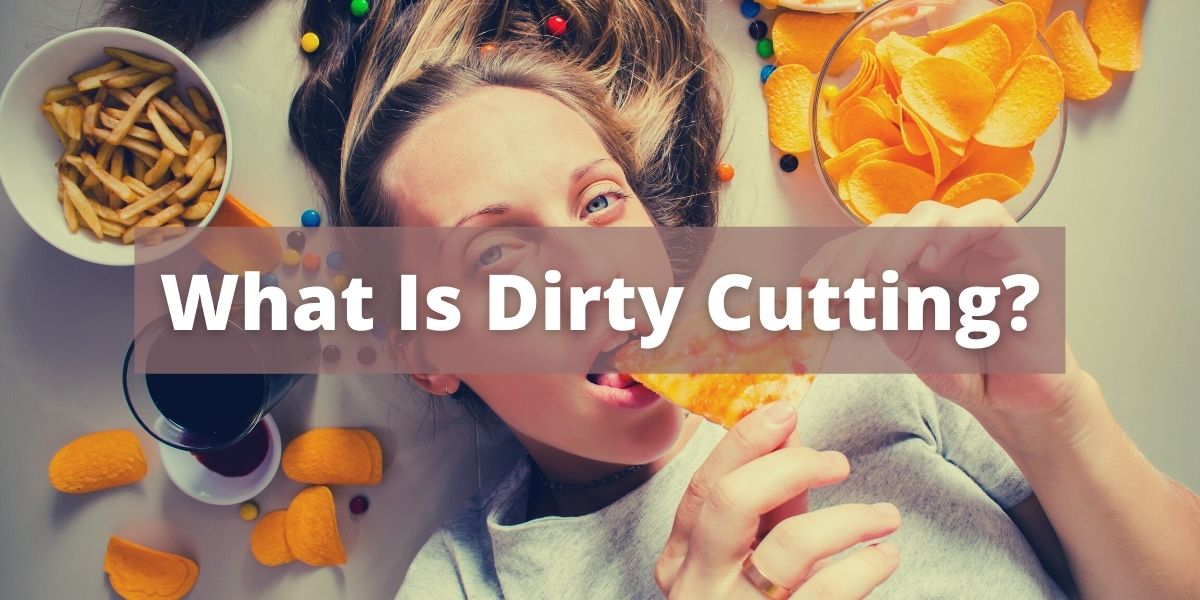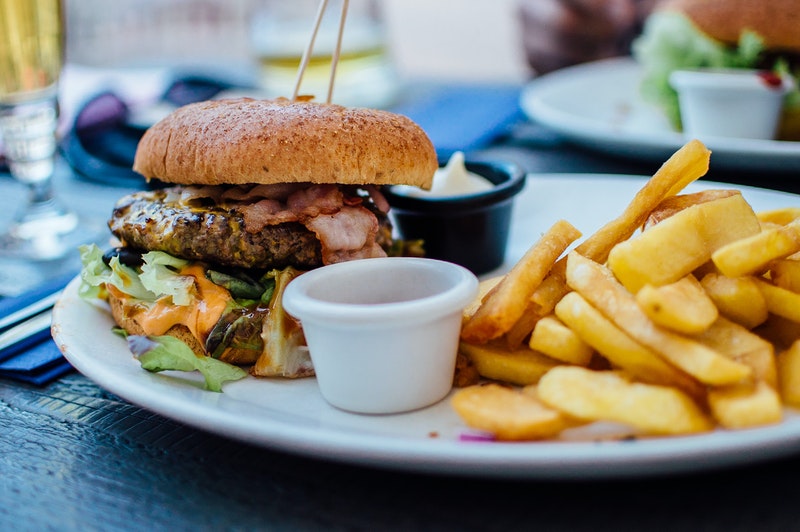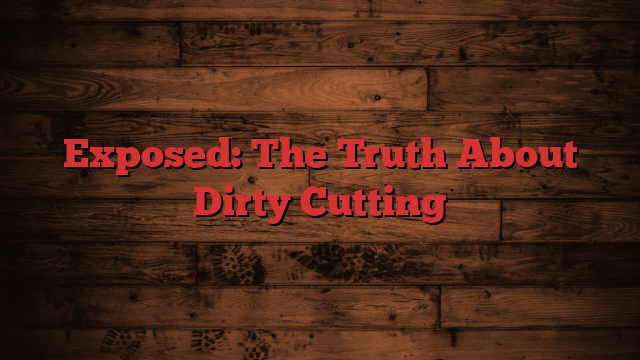Have you ever heard of dirty cutting? It might sound like a quick and easy way to shed some pounds, but the truth is far from glamorous. In this article, we will discuss the topic of dirty cutting in detail and uncover the hidden dangers it poses to your health. So, buckle up and get ready to learn more about this risky weight loss method.
Dirty cutting is a term used to describe a dangerous practice of extreme calorie restriction and excessive exercise in order to rapidly lose weight.
It often involves cutting out entire food groups, drastically reducing caloric intake, and pushing your body to the limits with grueling workouts. While the promise of quick results may be tempting, the consequences of dirty cutting can be severe.
Not only does it put immense strain on your body and mind, but it can also lead to nutrient deficiencies, muscle loss, hormonal imbalances, and even eating disorders.
In the following article, we will delve deeper into the harmful effects of dirty cutting and explore healthier alternatives for achieving sustainable weight loss. Stay tuned to discover the truth about dirty cutting and make informed decisions about your well-being.

Understanding Dirty Cutting
What is dirty cutting?
Dirty cutting is a term used to describe unhealthy and dangerous methods individuals use to achieve rapid weight loss, often in a short period of time. These methods may include extreme calorie restriction, dehydration techniques, and excessive exercise. The term “dirty cutting” suggests that these methods are harmful and can have serious consequences for both physical and mental health.
Why do people engage in dirty cutting?
People may engage in dirty cutting for various reasons. In today’s society, there is increasing pressure to achieve a certain body standard, whether it be influenced by social media, cultural expectations, or personal insecurities. Many individuals resort to drastic measures in an attempt to conform to these ideals, without considering the long-term consequences. Additionally, there is often a desire for quick results and a lack of understanding about healthy and sustainable weight loss methods.
Risks and dangers of dirty cutting
Engaging in dirty cutting poses several risks and dangers to one’s health. The extreme measures involved can lead to severe physical and mental health complications. Some of the risks include:
Unhealthy Methods of Dirty Cutting
Extreme calorie restriction
One common method of dirty cutting is extreme calorie restriction. This involves drastically reducing calorie intake to unsustainable levels. While it may result in quick weight loss initially, over time, it can lead to nutrient deficiencies, muscle loss, and a weakened immune system.
Dehydration techniques
Another unhealthy method employed in dirty cutting is the use of dehydration techniques. These methods can involve excessive sweating, diuretics, or sauna use to shed water weight quickly. However, dehydration puts a strain on the body and can lead to electrolyte imbalances, kidney problems, and even heatstroke.
Excessive exercise
Excessive exercise is often utilized as a means of dirty cutting. Individuals may spend hours at the gym, engaging in intense workouts without allowing their bodies adequate time to rest and recover. This can result in overtraining syndrome, injuries, and a negative impact on overall well-being.

The Negative Effects of Dirty Cutting
Muscle loss and reduced performance
One of the most significant negative effects of dirty cutting is muscle loss. When the body is deprived of necessary nutrients and calories, it turns to muscle tissue as an energy source, leading to muscle wasting. This can result in a decrease in strength, endurance, and overall athletic performance.
Metabolic damage and hormonal imbalances
Dirty cutting can have long-lasting effects on the metabolism and hormonal balance within the body. Drastic calorie restriction and excessive exercise can disrupt the thyroid gland, leading to a slowed metabolism. This makes it harder to lose weight in the future and can result in metabolic damage. Additionally, hormonal imbalances can occur, leading to irregular menstrual cycles, decreased libido, and other reproductive health issues.
Psychological impacts
Dirty cutting can also take a toll on an individual’s mental health. The constant focus on restrictive eating, extreme exercise, and weight loss can lead to obsessive thoughts and behaviors surrounding food and body image. This can contribute to the development of eating disorders, such as anorexia nervosa or bulimia nervosa, and negatively impact one’s overall quality of life.
The Role of Nutrition in Healthy Weight Loss
Importance of a balanced diet
In contrast to dirty cutting, a healthy weight loss plan involves prioritizing a balanced diet. This means consuming a variety of foods from all food groups, including fruits, vegetables, whole grains, lean proteins, and healthy fats. A balanced diet provides the body with essential nutrients and promotes overall well-being.
Proper hydration and its benefits
Proper hydration is also crucial for healthy weight loss. Drinking an adequate amount of water helps to regulate bodily functions, aids in digestion, and can even help to curb unnecessary food cravings. Staying hydrated also ensures that the body is able to effectively metabolize stored fat for energy.
Role of macronutrients and micronutrients
Macronutrients, which include carbohydrates, proteins, and fats, are essential for the body’s daily functions. Each macronutrient plays a specific role in providing energy, supporting muscle growth and repair, and maintaining overall health. Likewise, micronutrients, such as vitamins and minerals, are necessary for proper bodily functions and can optimize weight loss efforts.

Creating a Sustainable and Healthy Weight Loss Plan
Seeking professional guidance
When embarking on a weight loss journey, it is essential to seek professional guidance. Registered dietitians or nutritionists can provide personalized advice and develop a customized meal plan that aligns with your individual needs and goals. They can also monitor progress and make necessary adjustments along the way.
Setting realistic goals
Setting realistic goals is important for sustainable weight loss. It is essential to recognize that healthy and permanent weight loss takes time and cannot be achieved overnight. By setting attainable goals, individuals can better adhere to their plan and avoid the pitfalls of quick-fix solutions like dirty cutting.
Implementing gradual changes
Implementing gradual changes is key to long-term success. Instead of making drastic and unsustainable changes to your eating and exercise habits, focus on incorporating small, manageable changes over time. This can lead to a sustainable lifestyle and promote overall health and well-being.
Alternative Methods for Healthy Weight Management
Incorporating regular exercise
Regular exercise is an integral part of healthy weight management. Engaging in a combination of cardiovascular exercises, strength training, and flexibility exercises can help to burn calories, build muscle, and increase metabolism. Find activities you enjoy, and aim for at least 150 minutes of moderate-intensity exercise per week.
Practicing mindful eating
Mindful eating involves paying attention to your hunger and fullness cues, as well as the taste and texture of the food you are consuming. By slowing down and savoring each bite, you are more likely to make healthier food choices, stay in tune with your body’s needs, and prevent overeating.
Getting sufficient rest and sleep
Adequate rest and sleep are often overlooked but are crucial for maintaining a healthy weight. Lack of sleep can disrupt hormones that regulate hunger and satiety, leading to increased cravings and a higher likelihood of making unhealthy food choices. Aim for 7-9 hours of quality sleep each night.

Building a Healthy Relationship with Food and Body Image
Addressing emotional eating
Addressing emotional eating is essential for developing a healthy relationship with food. Emotional eating involves using food as a coping mechanism for stress, boredom, or other emotions. Finding alternative ways to manage emotions, such as engaging in hobbies, talking to a friend, or practicing relaxation techniques, can help break this cycle.
Cultivating self-acceptance
Cultivating self-acceptance plays a significant role in building a healthy relationship with body image. Recognize that bodies come in all shapes and sizes, and no one size fits all. Focus on self-care, nurturing your body with nourishing food, and engaging in activities that bring you joy, rather than striving for an unrealistic and often unhealthy ideal.
Challenging societal beauty standards
Challenging societal beauty standards is crucial in promoting a positive body image for ourselves and others. Recognize that beauty comes in many forms and is not solely defined by weight or appearance. Surround yourself with positive influences, diversify your social media feed, and advocate for inclusive representation in the media.
Understanding the Importance of Mental Health
Identifying and managing stress
Identifying and managing stress is essential for overall well-being, including healthy weight management. Chronic stress can lead to emotional eating, disruptions in sleep patterns, and a decrease in motivation to engage in healthy behaviors. Find healthy coping mechanisms for stress, such as exercise, meditation, or journaling, to help prevent the negative impact on weight loss efforts.
Seeking support from loved ones
Support from loved ones is invaluable when it comes to achieving and maintaining a healthy weight. Surround yourself with individuals who are supportive of your goals and provide encouragement along the way. Having someone to share your successes and challenges with can make the journey feel more manageable and less isolating.
Developing healthy coping mechanisms
Developing healthy coping mechanisms is essential for maintaining mental well-being. Engage in activities that bring you joy, promote relaxation, and relieve stress. This can include hobbies, spending time in nature, practicing mindfulness, or seeking professional help if needed.

Educating Others on the Dangers of Dirty Cutting
Raising awareness through social media
Raising awareness about the dangers of dirty cutting can be done through social media. Share accurate information, personal stories, and educational resources that emphasize the importance of prioritizing long-term health over quick fixes. Encourage others to seek professional guidance and adopt healthy weight loss methods.
Sharing personal experiences
Sharing personal experiences can be a powerful way to educate others about the dangers of dirty cutting. If you have overcome struggles with unhealthy weight loss methods, sharing your journey can inspire and resonate with others. By speaking openly about the negative effects and promoting healthy alternatives, you can make a difference in promoting a healthy relationship with food and weight.
Encouraging healthy practices
Encouraging healthy practices can help individuals make informed choices about their weight loss journey. Utilize your own experiences and knowledge to guide and support others. Emphasize the importance of nourishing the body with nutrient-dense foods, engaging in regular exercise, and prioritizing mental well-being.
Conclusion
Exposing the truth about dirty cutting is essential to promoting healthy and sustainable weight loss. The risks and dangers associated with these methods far outweigh any short-term benefits. By prioritizing long-term health over quick fixes, embracing healthy and sustainable weight loss methods, and empowering others with knowledge, we can shift the focus away from harmful practices and move towards a society that values overall well-being.




